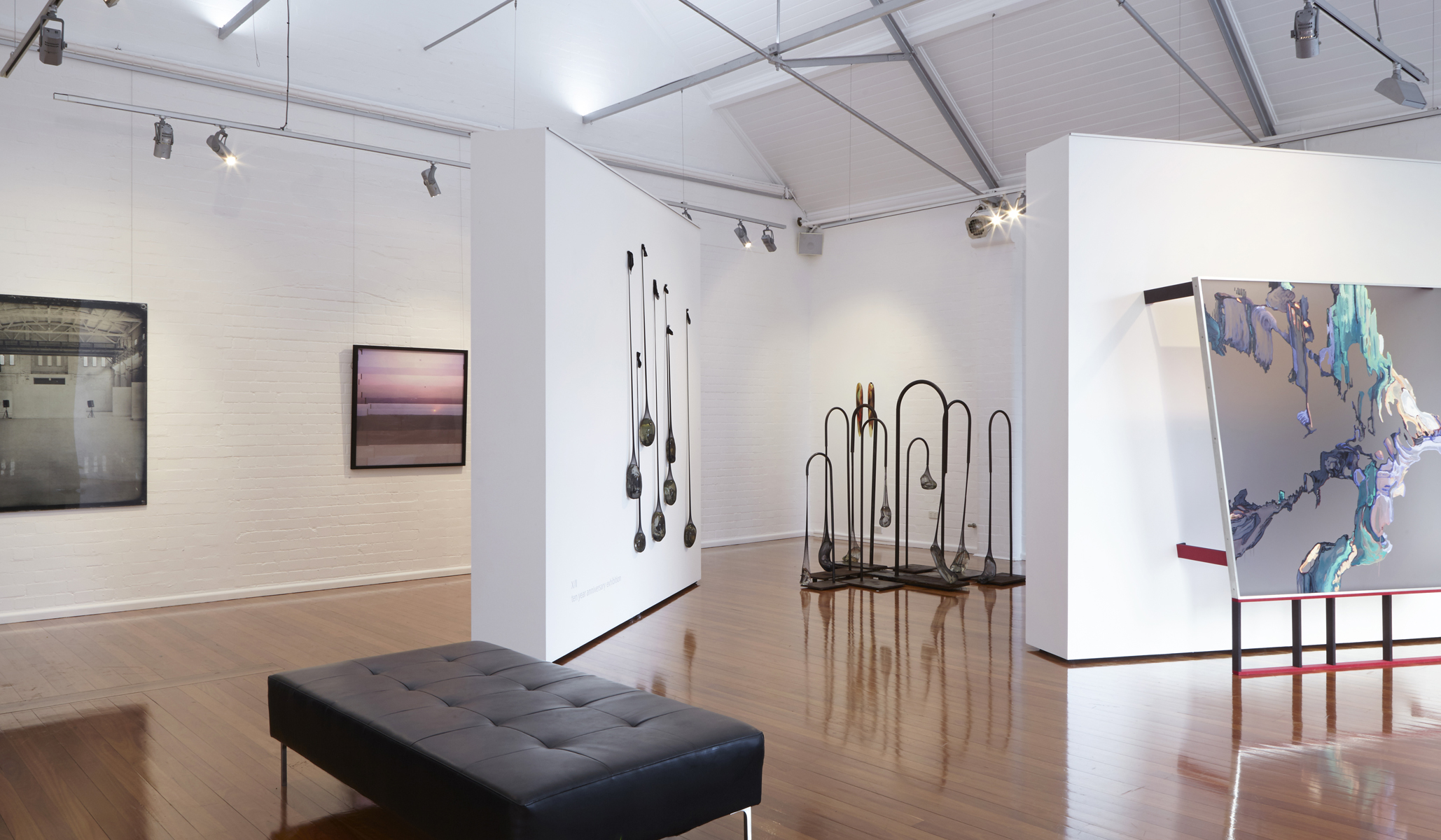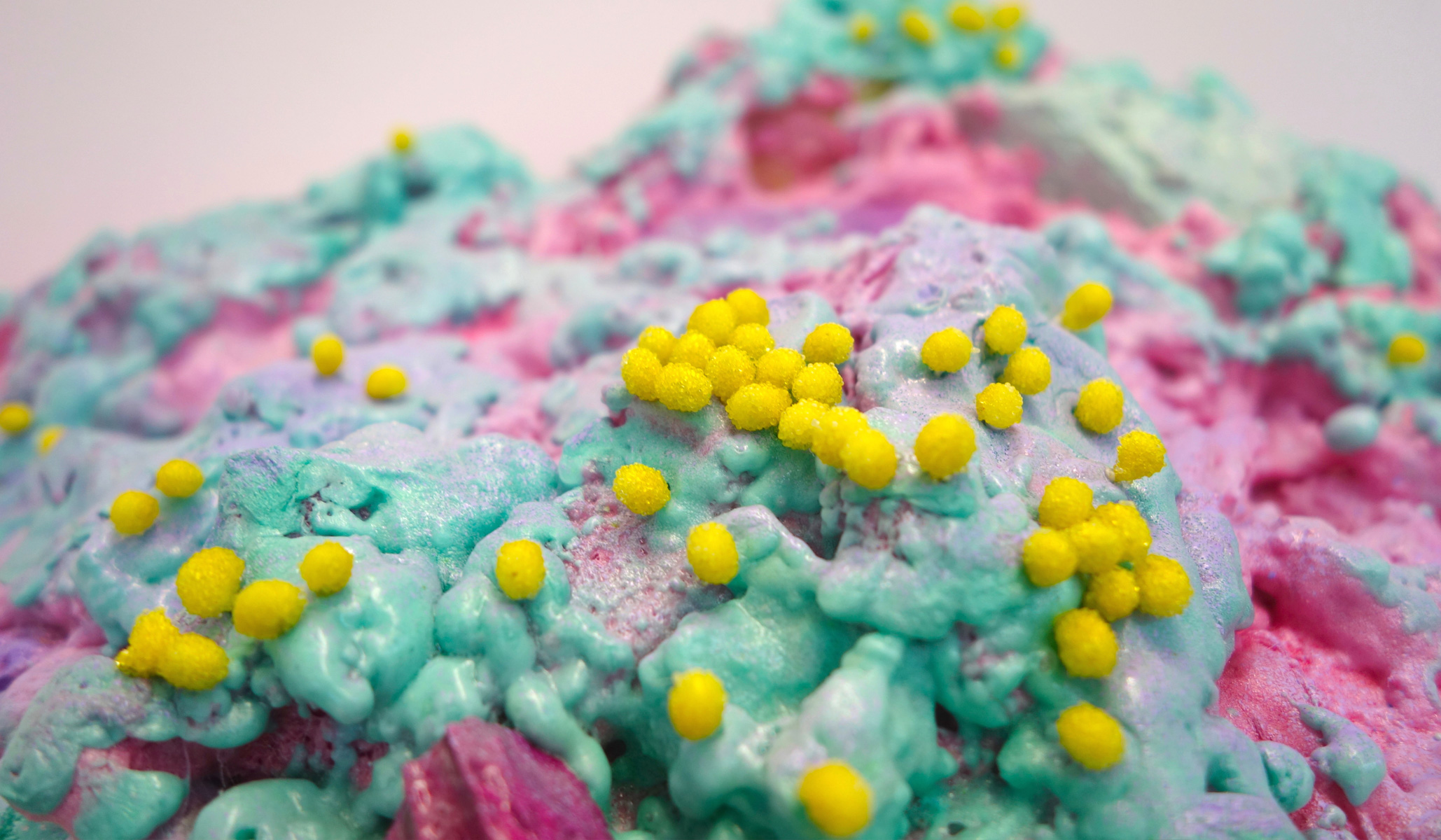Exhibition
JESS MACNEIL
BEN ALI ONG
OWEN LEONG
GIAN MANIK
SVETLANA BAILEY
EMILY SANDRUSSI
NOULA DIAMANTOPOULOS
HAYDEN FOWLER
STEVIE FIELDSEND
SHOUFAY DERZ
CAMILLE HANNAH
REBECCA BEARDMORE
GARY SMITH
LOUISE ZHANG
SYLVIA SCHWENK
X/II is the second phase of the ten-year anniversary celebration of the art and artists of Artereal. It continues the decade-long conversations around identity, spirituality, environmental impacts, the languages of light and the materials of art and Artereal Gallery’s ongoing emphasis on experimental and innovative practices.
The glowing neon sculpture, Here. I Am, by Noula Diamantopoulos, signals both a sense of arrival and a conundrum, characteristic of her question– based Quest performances and her multi-disciplinary practice.
Automatic writing and film noir are a major influence for photo artist Ben Ali Ong. A darkness that is both physical and psychological characterises his grainy, black and white photographs. A sense of the surreal, with the mystique of an underlying open narrative is palpable in his works.


The focus of photo artist Svetlana Bailey is on the ephemeral. Empty building interiors in China are shot in the retro format of daguerreotype that the artist likens to “… a breath of fog on a mirror”. Her subsequent process of digital scanning and printing in very large format ‘freezes’ the image, escalates the imperfections and distorts the incredibly fine detail, akin to the manner of memory.
Domino Theory is Emily Sandrussi’s contemporary ‘memento mori’. Scanning photographic negatives taken by her stepfather decades earlier during service as a conscript in the Vietnam War, Sandrussi exploits the spontaneous corruptions and glitches in the digital processing and the interaction with the surface marks of dust, scratches and fingerprints. Manipulating and integrating these traces and
accretions, she acknowledges the passage of time, the rigours and transit of the negatives from a war-zone, their history of non-recognition and re-discovery, and the imprint of a family of hands.
Owen Leong’s sculpture, Emotional Geometry (selenite) signals a deeper engagement with the artist’s Asian heritage; turning towards Chinese medicine, philosophy, and ancient systems of cultural knowledge as a gesture towards healing. A gold ‘geodesic’ grid simulating a force field of energy based on acupuncture meridians encases a white crystalline log of selenite that in crystal lore is aligned with the energies of instinct and emotional wellbeing.
Gian Manik’s preoccupation is with the representation of vibration. His approach is a way of ‘re-presentation’ rather than reproduction… Untitled 2, devolves around the form and resonance of the number “10”. The circular canvas is similar in shape to the wheel of fortune to which 10 relates in the Tarot. In the Numerological scale of vibrations, 10 signifies vitality and is a symbol of wholeness. His imagery
draws from the subject of the mirror, a recurring motif for Manik, to both “offer abstract images and to hold what was captured as a reflection”.
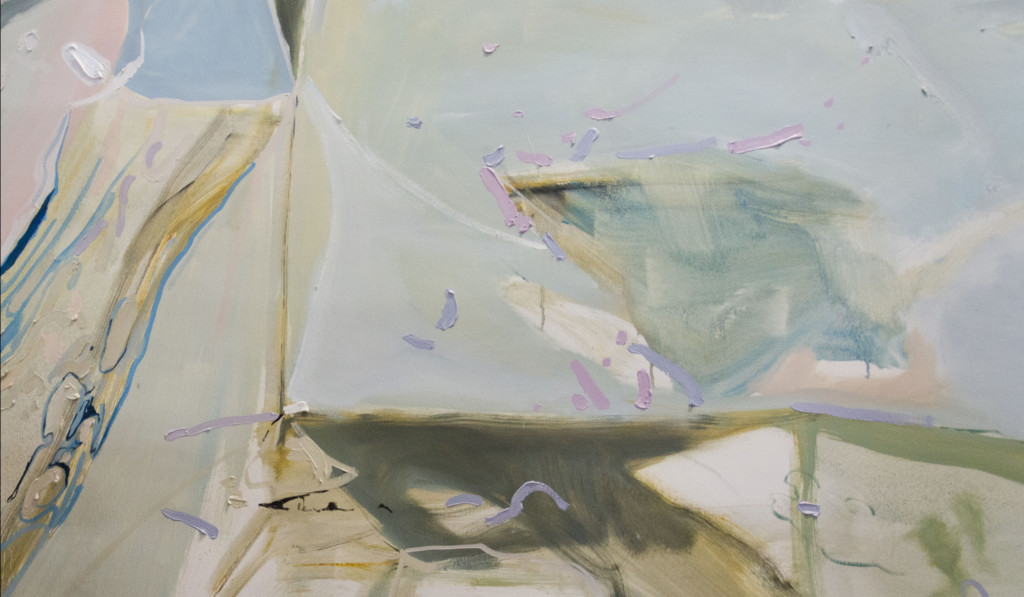
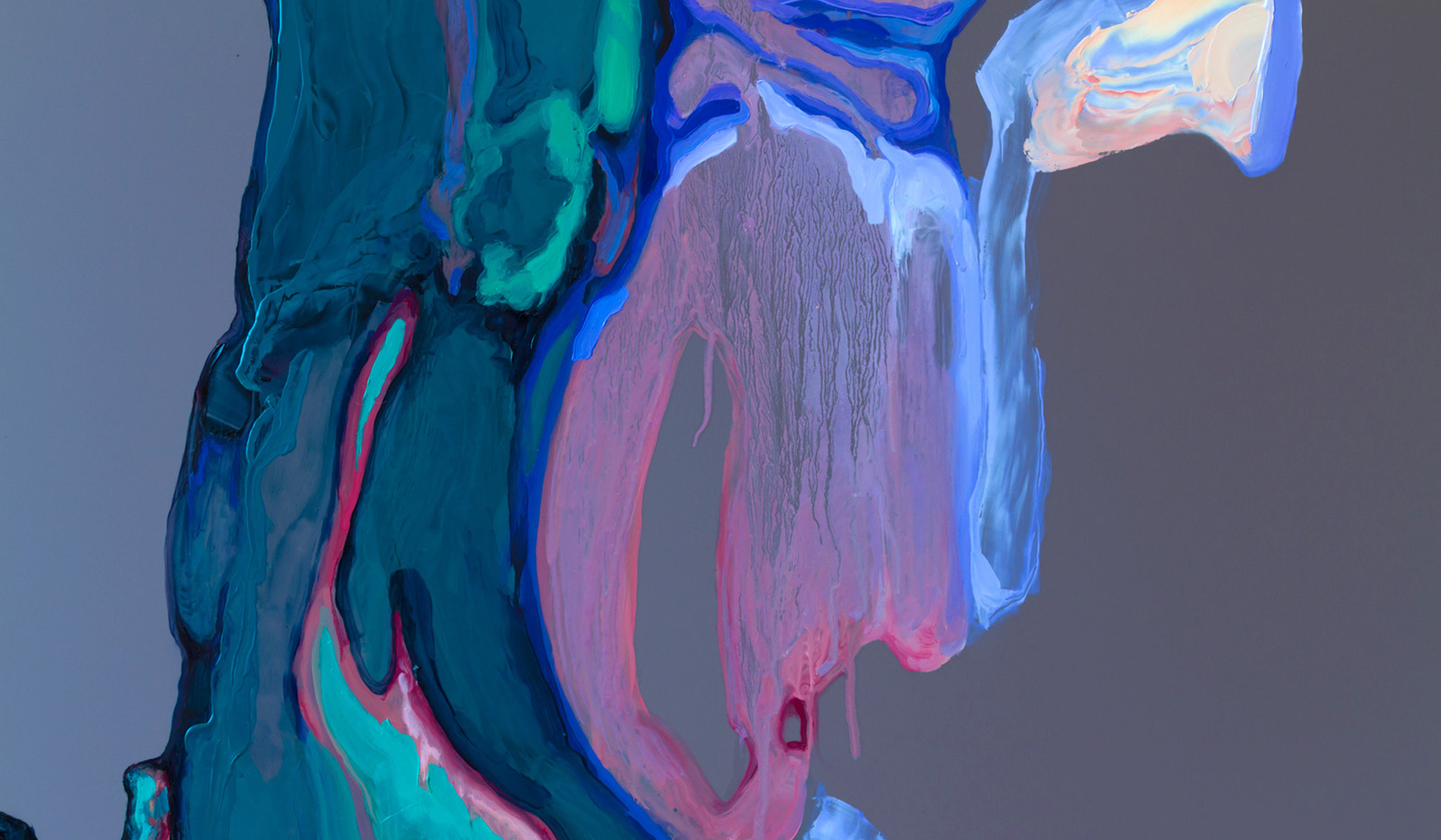
The Familiar Strange (Grey Rhombus) is from Jess MacNeil’s, Unfound series of large paintings-cumsculpture. Her works develop as cumulatively constructed images of ‘landscapes’, unfolding from fragment to fragment for a strange coexistence of presence and absence, orientation and disorientation. Her way of working is integral to and founded in the moving image and is revealing of the process and skeleton of art.
The visceral Love Stretch sculptures of Stevie Fieldsend are steeped and congealed in the juice and sap of the life force; the weight and tug of belonging and not belonging, the bodily memory of transitional stages in life, of sex, birth and
death, trauma, grief, desire and the tactile and potent power of female courage, protection, beauty, suffering and resilience. The totemic sculptures are a fusion of radiant
light, the transparency and heft of sacs of molten glass, the grainy residue of ink dark soot, the strength and bow of steel.
Shoufay Derz is inspired by a wish for a greater connection to something beyond the isolated individual. Words, their meaning, their artistry, their physical form, and the materials and implements of their making, recur in her practice. Many of these elements are implicit in the poignant video installation ‘洗手 (xǐshǒu) Wash Hands with cairn’ with its ‘panning’ for a sense of connection, for a touchstone between estranged individuals. The ritual hand washing is symbolic of cleansing and a means of healing – with ink a salve, a vehicle for words, for revelation of a
hidden common language. The stone cairn is at once memorial, grave stone and a marker for way-finding.
Multi disciplinary artist Sylvia Schwenk looks at the relationship between performance and the everyday, reflecting upon the significance and beauty of commonplace activities and spaces. The workers’ lift is filmed in a large shopping centre in Cologne, Germany where the sleek
glass-walled lift moves rhythmically and silently between floors in a continuous loop, never stopping. The workers glide on and off in concert with its flow. Man and machine engage in a form of pas de deux, a daily ritualistic dance where the basic step is so simple yet becomes more
beautiful with repetition.


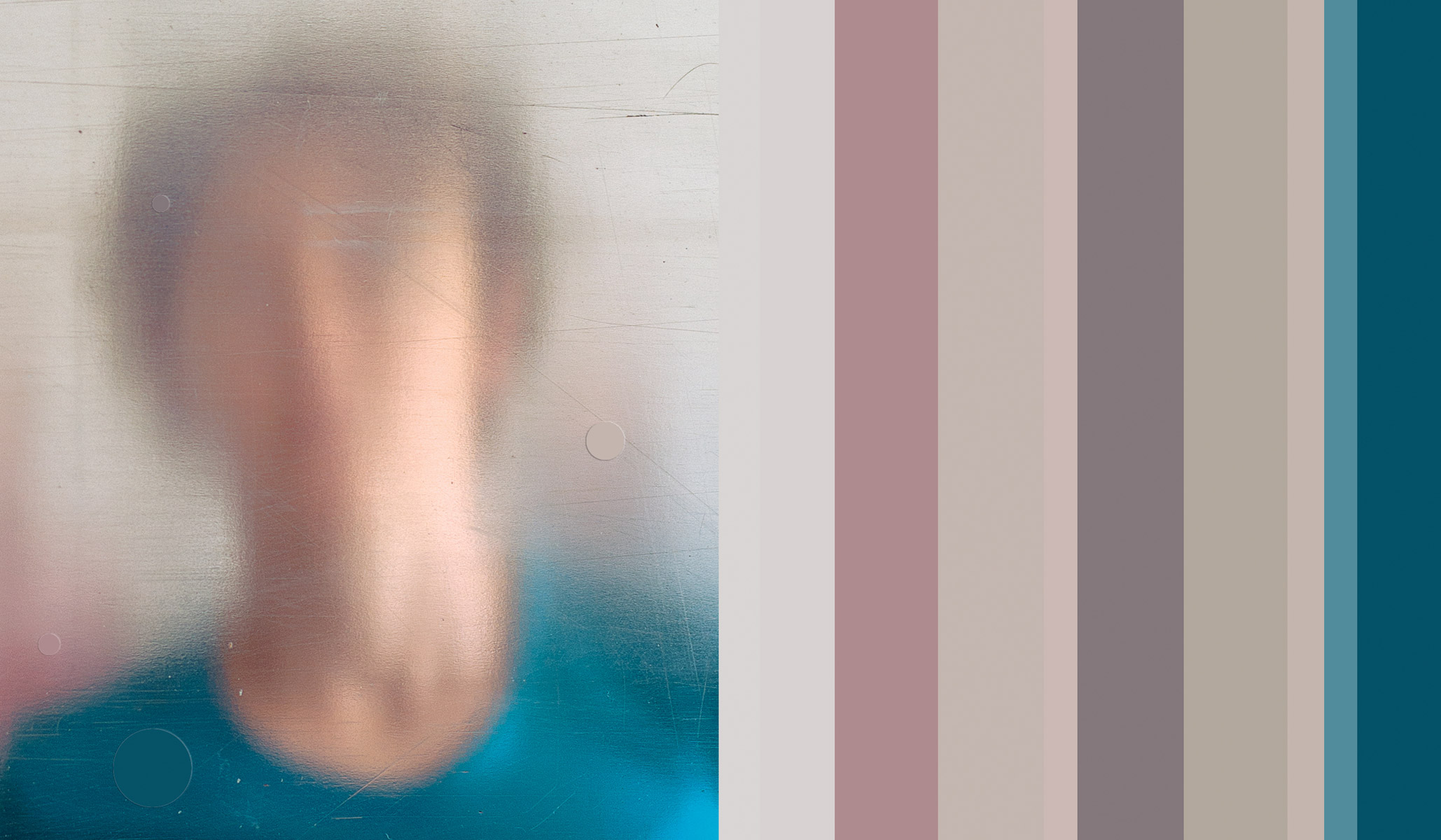
With Left to Right Face Rebecca Beardmore returns to the reflective and reflected face photographed through the polished and scarred surface of sheet steel to blur the distinguishing features of the subject, and to engage the viewer in the self-conscious act of seeing. The action of
‘reading’ the image (left to right) is extended in the panel of printed bands of tonal flat colour, sampled from the photographic picture plane and arranged to loosely appropriate Max Meldrum’s analytical approach to a scientific order of ocular impressions.
Hayden Fowler’s Your Death images are from a series of performances, a poignant and permanent requiem for New Zealand’s lost bird life and eco systems, in which the artist submits his own body to a ritualistic tattooing on his torso
of the now extinct Whekau or Laughing Owl in flight.
Claude Jones transposes animals as both perpetrators and victims, while employing humour, soft pastel colours and a decorative ‘storybook’ style for A dying spectator sport, a
work that belies its sinister narrative content in emulation of the ‘sugar-coating’ of the sordid underbelly of ‘legitimised’ mistreatment and exploitation of animals for food, entertainment and sport.
Camille Hannah’s Erotes 1 is tactile, seductive, voluptuous. The artist rejoices in the viscosity and sensuality of the paint medium and the emotional qualities of colour. The two sleek tapered convex Perspex ellipses that form the diptych appear wing-like, emblematic of the Erotes, a collective of small winged Greek gods of love and desire.


Gary Smith’s paintings are forays into the processes, properties and materials of painting for a form of pure painting. His works are an amalgam of layers of dense underpainting, old master techniques of thinning and glazing and accretions of impasto visual texture.
Louise Zhang rejoices the themes, potentialities and synthetic materials of the fantasy visualeffects film-set makers and theme park designers. Her wall of clusters of candy coloured glossy, phantasmagorical sculptures is other worldly. The works are overtly synthetic, cute yet verging on the grotesque. The installation, More than a few moons, modelled from viscous Polyfoam and resin, plaster, glass and glitter is a celebration of artifice and the vivid fluorescent aura and influences from creations of computer generated and screen-based imagery, yet Zhang’s sculptures consciously retain evidence of the hand made and the marks of the maker.
Barbara Dowse
Curator








